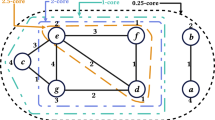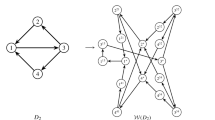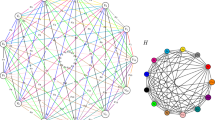Abstract
We first present a literature review of heuristics and metaheuristics developed for the problem of coloring graphs. We then present a Greedy Randomized Adaptive Search Procedure (GRASP) for coloring sparse graphs. The procedure is tested on graphs of known chromatic number, as well as random graphs with edge probability 0.1 having from 50 to 500 vertices. Empirical results indicate that the proposed GRASP implementation compares favorably to classical heuristics and implementations of simulated annealing and tabu search. GRASP is also found to be competitive with a genetic algorithm that is considered one of the best currently available for graph coloring.
Similar content being viewed by others
References
B. Bollobas and A. Thompson, “Random graphs of small order,” Annals of Discrete Mathematics, vol.28, pp. 249–255, 1985.
D. Brelez, “New methods to color vertices of a graph,” Comm. ACM, vol. 22, pp. 251–256, 1979.
M. Chams, A. Hertz, and D. de Werra, “Some experiments with simulated annealing for coloring graphs,” European Journal of Operational Research, vol. 32, pp. 260–266, 1987.
T.F. Coleman and J.J. More, “Estimation of sparse Jacobian matrices and graph coloring problems,” SIAM J. Numer. Anal., vol. 20, no. 1, pp. 187–209, 1983.
D. Costa, “An evolutionary tabu search algorithm and the NHL scheduling problem,” INFOR, vol. 33, no. 3, pp. 161–178, 1995.
D. Costa, A. Hertz, and O. Dubuis, “Embedding of a sequential procedure within an evolutionary algorithm for coloring problems in graphs,” Journal of Heuristics, vol. 1, no. 1, pp. 105–128, 1995.
E.D. Dahl, “Neural networks algorithms for an NP-complete problem: Map and graph coloring,” IEEE International Conference on Neural Networks, IEEE: New York, 1987, pp. 113–120.
A.E. Eiben, J.K. van der Hauw, and J.I. van Hemert, “Graph coloring with adaptive evolutionary algorithms,” Dept. of Computer Science, Leiden University, The Netherlands, 1997.
T. Feo and M.G.C. Resende, “A probabilistic heuristic for a computationally difficult set covering problem,” Operations Research Letters, vol.8, pp. 67–71, 1989.
T. Feo and M.G.C. Resende, “Greedy randomized adaptive search procedures,” Journal of Global Optimization, vol. 2, pp. 1–27, 1995.
C. Fleurent and J.A. Ferland, “Genetic and hybrid algorithms for graph coloring,” Annals of Operations Research, vol. 63, pp. 437–464, 1996.
M.R. Garey and D.S. Johnson, Computers and Intractability: A Guide to the Theory of NP-Completeness, W.H. Freeman & Co., San Fransisco, 1979.
A. Hertz and D. deWerra, “Using tabu search techniques for graph coloring,” Computing, vol. 39, pp. 345–351, 1988.
J.H. Holland, Adaptation in Natural and Artificial Systems, University of Michigan Press: Ann Arbor, MI, 1975.
J.J. Hopfield and D.W. Tank, “Neural computation of decisions in optimization problems,” Biological Cybernetics, vol. 52, pp. 141–152, 1985.
A. Jagota, “An adaptive, multiple restarts neural network algorithm for graph coloring,” European Journal of Operational Research, vol. 93, pp. 257–270, 1996.
D.S. Johnson, C.A. Aragon, L.A. Mcgeoch, and C. Schevon, “Optimization by simulated annealing: An experimental evaluation—Part II (graph coloring and number partitioning),” Operations Research, vol. 31, pp. 378–406, 1991.
S. Kirkpatrick, C.D. Gelatt Jr., and M.P. Vecchi, “Optimization by simulated annealing,” Science, vol. 220, pp. 671–680, 1983.
F.T. Leighton, “A graph coloring algorithm for large scheduling problems,” J. Res. Nat. Bur. Standard, vol. 84, no. 6, pp.489–506, 1979.
G. Lewandowski and A. Condon, “Experiments with parallel graph coloring heuristics,” Technical Report 1213, Computer Science Department, University of Wisconsin, Madison, 1993.
D.W. Matula, G. Marble, and J.D. Isaacson, “Graph coloring algorithms,” in Graph Theory and Computing, R.C. Read, (Ed.), Academic Press: New York, 1972, pp. 104–122.
P.M. Pardalos, T. Mavridou, and J. Xue, “The graph coloring problem: A bibliographic survey,” in Handbook of Combinatorial Optimization, D.-Z. Du and P.M. Pardalos (Eds.), vol. 2, 1999, pp. 331–395.
K. Stecke, “Design planning, scheduling and control problems of flexible manufacturing,” Annals of Operations Research, vol. 3, pp.3–12, 1985.
M. Trick, “The second DIMACS challenge,” 1993, http://mat.gsia.cmu.edu/challenge.html.
D.J.A. Welsh and M.B. Powell, “An upper bound for the chromatic number of a graph and its application to timetabling problems,” Comput. J., vol. 10, pp. 85–86, 1967.
D.C. Wood, “Atechnique for coloring a graph applicable to large scale timetable problems,” Computer Journal, vol. 12, pp. 317–322, 1969.
Author information
Authors and Affiliations
Rights and permissions
About this article
Cite this article
Laguna, M., Martí, R. A GRASP for Coloring Sparse Graphs. Computational Optimization and Applications 19, 165–178 (2001). https://doi.org/10.1023/A:1011237503342
Issue Date:
DOI: https://doi.org/10.1023/A:1011237503342




